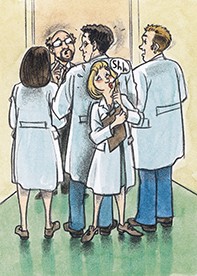Innocence revisited – 24
Dr Barbara Kendall recalls her experiences of medical school from the perspective of a trained educator.
‘...And gladly wolde he lerne, and gladly teche.’
Geoffrey Chaucer, The Canterbury Tales, c. 1400
I came to medicine moderately late (aged 31) and somewhat disadvantaged by having previously been trained to be an educator. This was probably more of a disadvantage than being a wife and a mother – although the interviewing committee at the University of NSW obviously felt the opposite when they questioned me about my ability to cope with cooking duties as well as being able to pursue medicine.
Hurdles of preclinical training
The first six months of medical school consisted of a series of hurdles that seemed to be purposefully designed to be insurmountable. Carbon chemistry weekly tests could only be passed if one had access to previously worked out solutions; physics practical classes were supervised by Gestapo clones. If you happened to be female and cute, you might be able to pass the exam by playing the game right. My salvation lay in having a talented friend who, having done the practical classes several hours before me, gave me logical and simplified diagrams of the experiments. His Wheatstone bridge diagram left theirs for dead. I can’t think of any time when I have used knowledge of the Wheatstone bridge in my medical career. Unfortunately my friend failed his third year twice and never graduated. Another extremely talented young woman who had not previously studied physics or chemistry for her HSC, but who nevertheless would have made a great doctor, did not even last the first six months.
The complexities of machines
The next two and a half years of mostly preclinical medicine passed as somewhat of a blur. We never revealed what we didn’t know – that would have been unforgivable. As a teacher, I found this to be the antithesis of all I had ever tried to do. I have always approached teaching by presenting a simplified view of a subject, exploring it in depth, and then drawing threads together to give a unified picture. Unfortunately, most people involved in teaching medicine in my preclinical years had no teaching qualifications and seemed to regard this aspect of their work as a chore.
Physiology was a major trial. The powers that be had determined that one must receive a pass in the two practical exams in order to pass the subject and, by extension, the year. Both of these exams consisted of correcting errors on a cathode ray oscilloscope. The rationale for this, according to the Professor of Physiology (verbatim to me), was that ‘…women are hopeless with machines in the hospital situation’. Having received a mark of 10% in the first exam, I was left with the incredible task of needing to achieve 90% in the second. Once again my friend came to the rescue.
Hiding through the clinical years
By the time I reached fourth year, my first major clinical year, most of my support systems had disappeared – a great loss to medicine. With a few notable exceptions, clinical teaching was no better than preclinical. We were encouraged to hide our lack of knowledge rather than to display our ignorance by asking questions. Being short, I managed to hide behind the six-footers quite often. On occasions, however, I received the humiliation of being belittled in front of my peers because of my lack of knowledge. I have never been able to understand the insensitivity and negativism of this method of teaching.
My gut feeling has always been that the best doctors are the best teachers and since graduating this has been reinforced. There are very few areas in medicine where communication and empathy are not important. It is not enough for a physician to have diagnosed a condition and feel happy about the treatment if the patient does not.
So, what did I learn as a medical student? Above all, I learned to hide my ignorance. What skills have I needed as a general practitioner? I have needed a willingness to admit my ignorance and then to do something about it; the ability to confront specialists and stand up for my patients; and, most importantly, the ability to explain in simple language to my patients what their problems are and what can be done about them.
Perhaps things have changed with the introduction of graduate medical courses – unfortunately, I doubt it. Medicine is about education. To be good educators we need to have better medical education in the first place.
Editor’s comment
Doctor Kendall’s recollections took me back to my own first years in medicine. After some years in the army it was all a bit strange, but fortunately I had learned how to survive in hostile environments. First year physics was a problem. In those days there were neither calculators nor computers; we used slide rules and log tables. Somehow I had acquired a marvellously complicated electrical engineer’s slide rule. On it there were scales of unimaginable complexity, so subtle that it needed two cursors to read its secrets rather than the usual one. I had no idea what it all meant.
Luckily, I found that if I wrote down the data I had acquired in my experiments, then a value that I knew to be very close to the right answer, and then the words ‘by slide rule’, none of the ‘Gestapo clones’ were game enough to pick the slide rule up and check my answer. It saved a lot of time and trouble, and the pub was just across the road. MT
Dr John Ellard

